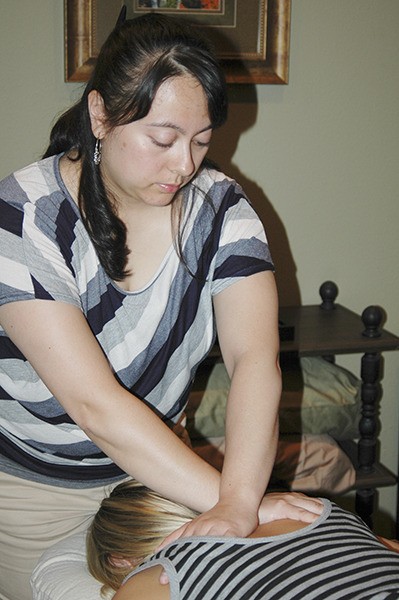After practicing as a physical therapist assistant for nearly 10 years Rose Reandeau first got introduced to myofascial release (MFR) in 2009 and has since submerged herself in the practice.
After studying myofascial release with physical therapist and leading authority on MFR John Barnes, Reandeau went on with her education to graduate from Renton Technical College in 2012 in order to open her own practice.
“As soon as I learned about it I was hooked,” Reandeau said. “I felt like this was the next step for my patients that were plateauing.”
Although born and raised in Port Angeles, Reandeau and her husband recently moved back to the peninsula last summer after traveling for both work and school. By mid-November Reandeau opened her own practice, Branching Waters MFR, located in The Lodge at Sherwood Village.
“I am excited to come back to my hometown and bring my technique to the area,” Reandeau said.
The name of Reandeau’s business derives from both her passion for the area and nature, but also represents how the fascia in bodies branches out in an interconnected web.
What is myofascia?
Myo is the root for muscle or relating to muscle and fascia is the “strong, tough, uninterrupted connective tissue that runs throughout the body like a three-dimensional web from head to toe,” Reandeau said.
When the myofascia gets bunched, similar to plastic Saran wrap for example, it can bind down on nerves, blood vessels and organs and thus can cause restrictions and pain.
Because the fascia cannot be detected on X-ray, CT or MRI scans it is often the reason for unidentified discomfort, Reandeau said.
Gentle techniques
To help release the fascia and allow it to unbind, Reandeau practices the “John F. Barnes method” of myofascial release. The Barnes technique utilizes a slow, gentle and sustained form of pressure to allow the body’s fascia to release.
Although Barnes has been practicing and educating on myofascial release for more than 40 years, Reandeau explained it takes a while for something “relatively new” to get out into common practice.
Easy to identify areas of the body that could benefit from myofascial release are places on the body that are hot, hard or tender, Reandeau said.
“By treating the fascia you’re able to treat the person as a whole rather than compartmentalizing and only treating the knee or the foot for example,” Reandeau said.
Despite the beneficial health potential myofascial release offers, Reandeau’s biggest challenge is educating her patients and getting them to understand the importance of taking an active role in their healing process.
“You have to be willing to looking within yourself and help heal yourself,” Reandeau said.
Who benefits?
Because the technique is so gentle anyone is a candidate for myofascial release. Currently, Reandeau has a mixed patient demographic from an infant and high school level athletes to senior patients.
To avoid limiting anyone, Reandeau is available for home visits if patients are too debilitated or unable to leave their residence.
“It (myofascial release) can be the other piece to the puzzle to help one function as well as they want to, whether that be less pain or more range of motion,” Readeau said.
In addition, to best treat her patients, Reandeau often works with the health care specialists next door to her practice in The Lodge at Sherwood Village. Reandeau enjoys the “collaborative environment” and ability to cross refer.
“My biggest goal is a generalized hope to bring more education to the area about what fascia is and that there are other tools available,” Reandeau said.
Reandeau is scheduling patients from 10 a.m.-6 p.m., Monday-Thursday. Call 670-1238.



